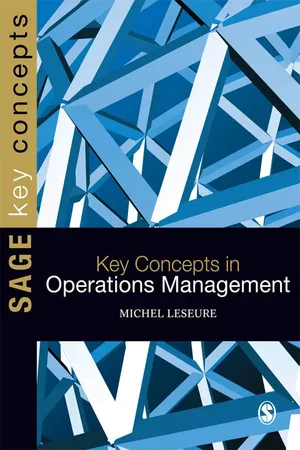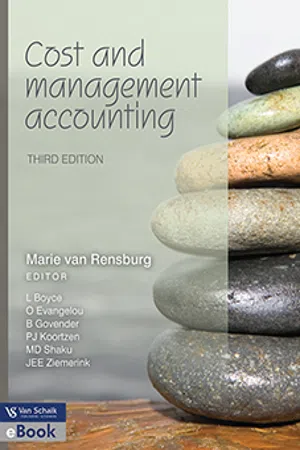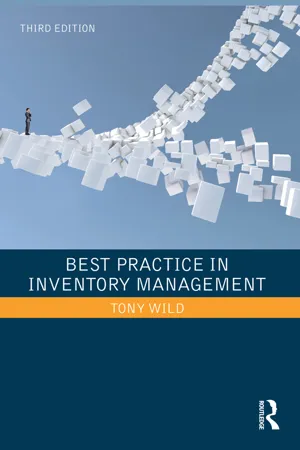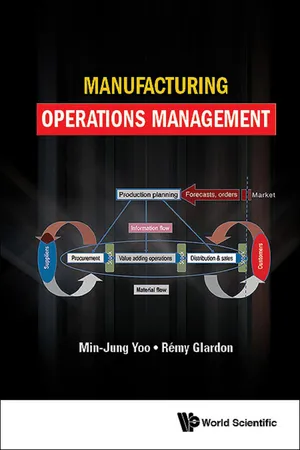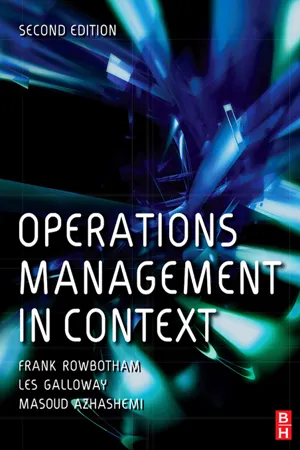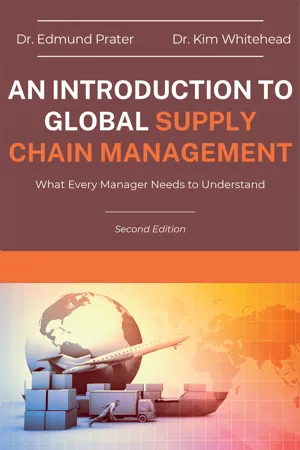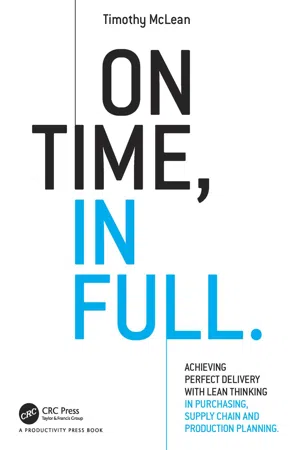Business
Inventory
Inventory refers to the goods and materials a business holds for the purpose of resale or production. It includes raw materials, work-in-progress, and finished goods. Effective inventory management is crucial for ensuring a balance between meeting customer demand and minimizing holding costs.
Written by Perlego with AI-assistance
Related key terms
Related key terms
1 of 4
Related key terms
1 of 3
10 Key excerpts on "Inventory"
- eBook - ePub
- Michel Leseure(Author)
- 2010(Publication Date)
- SAGE Publications Ltd(Publisher)
InventoryManufacturing Inventory has traditionally been described within three categories:Inventory refers to the stock of various items which is kept on site or in a facility in anticipation of a future use.- Raw Materials Inventory: Sheets of metal, wood panels, etc. that are purchased for the purpose of using them in the manufacture of a product.
- Work in Process Inventory: Partially completed products which are located on the shopfloor and which are not ready for sale.
- Finished Goods Inventory: Goods which are finished and ready for sale, but which have not yet been purchased by final customers. This also includes goods purchased for resale, as for example in the case of a supermarket.
Factories often involve many additional types of Inventory: spare parts, supplies, indirect materials, tools and fixtures, etc. Pipeline Inventory is composed of units that have left a production facility and are in the process of being distributed to the end customer.Service organisations can also require extensive Inventory keeping. Large hotels for example have to hold a large variety of items in stock such as food, beverages, cleaning chemicals, office stationeries, office sundries, emergency items, china, glass, cutlery, linens, etc. The diverse nature of Inventory can make Inventory management (see Inventory Systems) a complicated task. Inventory complexity is often measured by the number of Stock Keeping Units (SKUs) associated with an organisation.In accounting terminology, Inventory is an asset, i.e. a resource from which future economic benefits can be derived. Operations managers are directly involved with the management of Inventory in order to increase the profitability and effectiveness of an organisation. The reasons why Inventory is a resource, (i.e. the positive motives for holding Inventory) are:- To meet anticipated demand
- eBook - ePub
Optimizing Your Supply-Chain Performance
How to Assess and Improve Your Company's Strategy and Execution Capabilities
- Raymond Kelly(Author)
- 2019(Publication Date)
- Productivity Press(Publisher)
Chapter 5Inventory-Management
Inventory-Management Overview/Purpose
Inventory is listed as an asset on a company’s balance sheet, and Inventory is typically defined as the finished goods available for sale or the raw materials used to produce finished goods. But it also includes the items needed to maintain production support activities (e.g., consumables, maintenance and repair, etc.) and to provide customer service. Inventory is often categorized based on its flow through the production cycle, i.e., raw materials, work-in-process, and finished goods. And Inventory represents one of the most important assets of a business because the turnover of Inventory represents one of the primary sources of revenue generation and subsequent earnings for the company’s shareholders (see Figure 5.1 ).Figure 5.1 Inventory-Management Techniques/Concepts.Inventory’s primary purpose is to meet customers’ demand. Inventory is an expensive asset and must be carefully managed and controlled. Inventory-management is the supervision of these non-capitalized assets (Inventory) and stock items.There are several important technical terms that pertain to an Inventory’s purpose and status:- Cycle stock . Cycle stock is the most active Inventory component and the most critical to prevent production being interrupted. Its amount is based on daily demand, replenishment times, lot-sizing rules, etc., as items are received and consumed (see Figure 5.2 ).
- Safety stock. Safety stock is Inventory that’s carried in excess of demand expectations to provide potential coverage for uncertainty in demand (a.k.a. demand volatility), variations in replenishment lead time, supply-quality uncertainties, and forecast errors (see Figure 5.2 ).
- In-Transit.
- eBook - ePub
- Van Rensburg M(Author)
- 2017(Publication Date)
- Van Schaik Publishers(Publisher)
2 , we have shown that the main objectives of Cost Accounting are cost accumulation, decision making and cost control. This chapter explains how Inventory valuation (or measurement) and Inventory management fit into the greater cost accounting framework.Inventory (or stock as it was previously known) is defined by International Accounting Standard 2: IAS 2 Inventories, as being (a) held for sale in the ordinary course of business; (b) in the process of production for such sale, or (c) in the form of materials or supplies to be consumed in the production process or in the rendering of services. Inventory valuation and management are important because Inventory is a critical element in any company. Inventory can further be classified asraw materials(materials to be used in the production process), work-in-process (material that has already entered the production process, but products are not complete) and finished goods or completed goods (products ready for sale). While it is important to study all of these, the focus of this chapter is on raw materials for a production company or resale items for a merchandiser .Another important concept when classifying raw materials relates to whether the material is direct or indirect material. Direct materials are those raw Inventory items that form the basic structure in production such as wood for a toy train. Indirect materials are important for the conversion of the basic structure into a finished product, and could include items such as screws, glue and paint.Whether a business is a manufacturing, merchandising or service organisation, Inventory is a very difficult asset to control and protect. However, proper management and control of Inventory will reveal opportunities for cost reduction, cost savings and cash flow improvement.3.2 Inventory piling and Inventory control
A significant amount of accounting information is devoted to planning and controlling the use of business resources (such as Inventory). The greater the value of Inventory, the more interested management is in effectively and efficiently controlling its use. A number of Inventory management systems have become popular in business. We discuss some of these further on in this section. First we look at costs in a little more detail. - eBook - ePub
- Jayanta Kumar Bandyopadhyay(Author)
- 2015(Publication Date)
- CRC Press(Publisher)
Chapter 8 Inventory Management 8.1 Introduction Inventories are stored resources such as materials and supplies carried on hand by a business organization either for sale or to provide inputs or supplies to the production processes. All businesses and institutions require inventories. Often, they form a substantial portion (from 20% to 60%) of the total assets. Financially, Inventory management is very critical to many companies. When inventories are reduced, their value is converted into cash, which improves cash flow and return on investment. On the other hand, there is a cost associated with carrying inventories, which increases operating costs and decreases profits of the company. Therefore, good Inventory management is essential to the success of a company. Inventory management is responsible for planning and controlling Inventory from the raw material stage to the finished product stage to be sold to customers. Since Inventory either results from production or supports production, it is not possible to manage the two separately. They must be coordinated, and inventories must be considered at each of the planning levels; thus, they become part of production planning, master production scheduling, and material requirements planning. Production planning is concerned with overall Inventory, master planning with end items, and material requirements planning with component parts and raw materials. 8.2 Aggregate Inventory Management At the production planning level Inventory management deals with total Inventory. This is called aggregate Inventory management. The concern here is managing inventories according to their classification (raw material, work in process, and finished goods) and the function they perform, rather than at the individual item level. It is financially oriented and is concerned with the costs and benefits of carrying the different classifications of inventories - eBook - ePub
- Tony Wild(Author)
- 2017(Publication Date)
- Routledge(Publisher)
1The basis of Inventory control- Conflicts which beset Inventory controllersa.
- What Inventory is there to achieve.
- How good Inventory management will improve profitability.
- The reasons for the current stockholding.
1.A The role of Inventory management
The success of a venture depends on its ability to provide services to customers or users and remain financially viable. For an organisation that supplies goods to its customers, the major activity is to have suitable products available at an acceptable price within a reasonable timescale. Many parts of a business are involved in setting up this situation. Initially it is the marketing and design departments, then purchasing and, in some cases, manufacture is involved. For an item which is already in the marketplace, the main activity is providing a continuity of supply for customers.Inventory control is the activity that organises the availability of items to customers. It co-ordinates the purchasing, manufacturing and distribution functions to meet marketing needs. This role includes the supply of current sales items, new products, consumables, spare parts, obsolescent items and all other supplies.Inventory enables a company to support the customer service, logistic or manufacturing activities in situations where purchase or manufacture of the items is not able to satisfy the demand. This could arise either because of the speed of purchasing, or because manufacturing is too protracted, or because the quantities demanded cannot be provided without stocks (i.e. the demand rate exceeds the maximum supply rate).Stock control exists at a crossroads in the operations of a company (Figure 1.1 - eBook - ePub
- Min-Jung Yoo, Rémy Glardon(Authors)
- 2018(Publication Date)
- WSPC (EUROPE)(Publisher)
The chapter begins by presenting basic concepts of Inventory management. Key vocabulary and fundamental problems are explained in the subsections which follow. Section 4 presents the cost modelling used in Inventory management. It is based on the Economic Order Quantity (EOQ) model, which is one of the oldest, but still most commonly used models for Inventory management. Its purpose and limiting assumptions will be discussed, followed by a presentation of various costs of holding Inventory. A special emphasis will be given to the logic of the model and assumptions, in order to properly adapt it to different manufacturing environments. In Section 5, various Inventory management methods are presented conceptually with example illustrations. This section tries to explain how to differentiate the various methods based on their respective hypotheses, fields of applications, strengths and weaknesses. Section 6 deals with the critical issues of uncertainty and how to cope with it. This is an important issue since one of the main purposes of maintaining inventories is to guarantee customer service level within an uncertain environment. In Section 7, the methodologies and statistical models used for calculating safety stocks are presented.5.2Basic concepts and definitions
Inventory refers to the amount of goods that is held at some location in a value adding network. It could take the form of raw material, parts, components or finished products. Various types of inventories can be found within a firm and can be classified into stock or WIP. •Stock: bound, identified materials outside of any operations processes. •WIP: Work In Progress, usually not identified. •Inventory: sum of stock and WIP.Both stocks and WIP can be located at different stages within the production system. For example, stock can be located at several locations within a firm or a group of companies. It can be found amongst the network of production resources (machinery, workstations, assembly lines, factories, etc.) and within the logistics resources (material handling systems, transportation resources, warehouses, retailers, etc.). - eBook - ePub
- Frank Rowbotham, Masoud Azhashemi, Les Galloway(Authors)
- 2012(Publication Date)
- Routledge(Publisher)
Raw materials are those items which are stored waiting to be worked on as a part of the delivery processes of the organization. Physically, they can usually be found, therefore, in a warehouse or stockroom from which the operational staff withdraw stock as they require it. Work-in-progress is material which is being worked as a part of the process. When this work is completed the material will have been transformed into its final state and is ready to move down the supply chain. Inventory in this state is referred to as ‘finished goods’.Case studyThese terms can be illustrated in the context of a McDonald’s restaurant. Potatoes, buns and meat, etc. are stored in the restaurant unit just beyond the cooking area. At this stage the items are raw materials. When the potatoes, etc. are drawn into the cooking area for processing they become work-in-progress. The notion of finished goods stocks is exemplified by the filled meal containers stacked on the racking behind the counter staff. In this case, of course, the finished goods remain stored for only a very short space of time.Some other classifications of Inventory are also in common use. ‘Consumable materials’ refers to those materials which are used (i.e. consumed) by the process but which do not form a part of the direct material which is passed down the supply chain. Oil to lubricate the machinery of the process would be an example of this type of material. Another classification is ‘service’ or ‘spare parts’. In some industries the outputs from the process are retained as spare items to provide support for users in the event of future breakdowns or exhaustion. Manufacturers of televisions need to be able to provide replacement on/off switches for the lives of their models, for instance.Case studyMorgan cars prides itself on being able to provide spare parts for models which it produced over forty years ago. These spares are stored on its main site and are seen as an essential part of the company’s commitment to the Morgan car enthusiasts. The availability of spares is perceived to be an important part of the brand image.One final category of Inventory is ‘buffer stocks’. Buffer stocks are materials which are being deliberately used to protect the operation from the otherwise disruptive effects of interruptions to supply or sudden increases in demand. Thus, raw materials, work-in-progress and finished goods might all be used to act as buffer stocks. Raw materials might be stockpiled to protect against possible supplier failures due, for example, to industrial action or extreme weather conditions. Work-in-progress might be built up prior to a key process so that it can keep on working even if supplying processes break down for a period. Finished goods can be built up so that sudden increases in demand can be met from stock so that the process is given time to increase its output in response. - eBook - ePub
An Introduction to Global Supply Chain Management
What Every Manager Needs to Understand
- Edmund Prater, Kim Whitehead(Authors)
- 2023(Publication Date)
- Business Expert Press(Publisher)
Solutions to deal with problems of Inventory management were developed as far back as 1915 by F. W. Harris. He developed the economic-lot-size equation. This equation sought to minimize the sum of Inventory carrying cost and setup cost related to production and Inventory control, when demands were certain. However, it was only in the early 1960s that concepts such as Inventory forecasting and safety stock were introduced to help deal with fluctuating demands.What Is Inventory Management? Inventory management encompasses processes that ensure product availability while reducing investment costs. For most companies, there are two forms of Inventory:• Physical Inventory includes all the materials that are tangible and required to fabricate the final product. And, the final product, including final pack-out materials.• Logical Inventory includes databases, Inventory tracking software, and other such intangible assets.Proper synchronization of these two inventories is essential for proper management of company assets. Inventory management also involves identifying the most effective source of supply for each item in each stocking location. Forecasting and replenishment are also integral to Inventory management.Why Do We Need Inventory Management?Inventory is the largest and most difficult asset to manage for any organization. Improper management of Inventory may lead to:• Overstocking: Excess Inventory can lead to increased costs, capital intensity, and potential obsolescence of stock, ultimately reducing the flexibility and profitability of the firm.• Shortages - eBook - ePub
Lawn Care or Landscaping Business
Step-By-Step Startup Guide
- (Author)
- 2016(Publication Date)
- Entrepreneur Press(Publisher)
CHAPTER 19 Stock Answers The Lowdown on InventoryW here would an apparel company be without clothing? An auto supply store without auto parts? A computer company without computers? Nowhere, of course. Understanding and managing your Inventory is one of the most critical factors in business success.Yet many entrepreneurs fail to answer such basic questions as “What items are the winners and losers?” and “How often does Inventory turn over?” Don’t make this mistake. Management education expert Ashok Rao believes that companies can increase their profitability 20 to 50 percent or more through careful Inventory management.tipInventory ControlInventory control doesn’t just mean counting. Take physical control of your Inventory, too. Lock it up or restrict access. Remember that Inventory is money.There is more to Inventory control than simply buying new products. You have to know what to buy, when to buy it, and how much to buy. You also need to track your Inventory—whether manually or by computer—and use that knowledge to hone your purchasing process.Startup entrepreneurs are at a disadvantage when it comes to Inventory control, says Rao. “They may not have the right kinds of systems to manage their Inventory. They don’t have the right kinds of skills for handling Inventory. They don’t know how to go about actually maintaining their Inventory, and they sometimes have to purchase in larger quantities than what they want or need.”Maintaining Enough InventoryYour business’s basic stock should provide a reasonable assortment of products and should be big enough to cover the normal sales demands of your business. Since you won’t have actual sales and stocking figures from previous years to guide you during startup, you must project your first year’s sales based on your business plan.When calculating basic stock, you must also factor in lead time—the length of time between reordering and receiving a product. For instance, if your lead time is four weeks and a particular product line sells 10 units a week, then you must reorder before the basic Inventory level falls below 40 units. If you do not reorder until you actually need the stock, you’ll have to wait four weeks without the product. - eBook - ePub
On Time, In Full
Achieving Perfect Delivery with Lean Thinking in Purchasing, Supply Chain, and Production Planning
- Timothy McLean(Author)
- 2017(Publication Date)
- Productivity Press(Publisher)
Chapter 5 Managing Inventory—If YouDo Not Have It, You CannotSell It What You Will Learn in This ChapterThe reasons Inventory is necessaryThe difference between a make-to-stock and make-to-order finished goods strategyCalculating safety stock and the right level of InventoryUsing a pull system to replenish finished goodsMeasuring stock-outs and Inventory accuracyManaging make-to-order supply to ensure on-time deliveryDo You Need Inventory?In Lean terms, you know that Inventory is waste. Your customers are unlikely to pay you one cent more for your product if you hold warehouses of Inventory than if you could meet their needs and hold no Inventory at all. So why should you hold Inventory? Understanding why Inventory is being held is perhaps the key to deciding how much (if any) Inventory to hold.Let’s take a very simple example. Imagine that your customer always purchased one product per day and you knew what that product would be. You would not need Inventory. You could just produce or obtain that one product each day, the customer would buy that product, and you would deliver on time every day.However, what if there was a delay, for example, you ran short of a material, there was a delay in shipping, or a machine broke down in your factory or at your supplier’s factory. Alternatively, what if your customer decided to order two products and you only had one? When your customer placed their order, you would not have the product available and you would let them down.After reflecting on this problem, you might decide that the risk of either your process or supply chain failing to deliver one product or the customer needing more than one product was too great and you could not afford to let the customer down this way. In this case, you would probably decide to have one product ready to sell in advance of the customer order. In other words, you would carry one product in Inventory.
Index pages curate the most relevant extracts from our library of academic textbooks. They’ve been created using an in-house natural language model (NLM), each adding context and meaning to key research topics.
Explore more topic indexes
Explore more topic indexes
1 of 6
Explore more topic indexes
1 of 4
